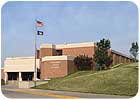
The National Center for Education Statistics reports that K-12 public school students are more likely to be a crime victim in school than away from school.
SDM examines education as a vertical market, including who’s playing that field and where the growth areas are.
The education market, including kindergarten through 12th grade (K-12) and colleges and universities, is large and diverse. There are more than 17,000 districts, 96,000 schools, three million teachers and 48 million K-12 students in the U.S. public school system alone. New school construction is increasing at five to eight percent a year, according to ADT Security Services, which provides security services to 15,000 schools and 1,400 colleges and universities nationwide.
As we kick off SDM’s vertical market series, we take you on a journey into the education market, which is a hot non-residential market for security systems. Security in education settings has gotten particular attention most recently because of the shooting at Virginia Tech University in April. Security dealers and systems integrators surveyed by SDM Magazine forecast the market to grow 15 percent for their companies in 2007 — surpassed only by commercial real estate (30 percent) and retail (21 percent).

By adding a smart chip to student ID cards in use for 10 years, Everglades High School, Miramar, Fla., is creating a cashless campus.
Market Goals 101
There are as many security goals as there are schools, but generally, all schools seek to protect:- People — students, faculty, staff.
- Careers — accusations of teacher or staff wrong doing, without evidence to the contrary, can end careers.
- Physical assets — possessions and premises.
1. Information.Ian Oliver, director, IBI Group, a Toronto-based consulting firm that has helped numerous schools implement security systems, says schools want “…tools that provide accessible, often court-admissible, information.” Guy Grace, manager of security and emergency preparedness, Littleton (Colo.) Public Schools, needs information about threats outside his schools. “We estimate 25 outside threats for every one inside,” he states. K-12 transportation departments need specialized systems to gather information about student behavior on buses. “Concern about potential terrorist attacks on buses also is increasing awareness of the security aspect of bus surveillance,” states Ian Radziejewski, president of Seon Design, a Coquitlam, British Columbia, Canada, mobile surveillance manufacturer.

3. Ease of operation. While educators want to understand the security system being implemented, Oliver adds that, “Educators want to be educators. They don’t want to have to mess with technology. If they can’t use a system easily, especially under pressure after an incident occurs, they may blame the dealer.” Seon’s Radziejewski adds that the first question a school transportation department will ask about a security technology is “how will this impact our workload?”
4. Proactive deterrent.Another reason educators turn to a security system is to proactively deter danger or threats. Schools want to prevent problems, not just respond when they occur. “Security breaches in other schools always make our phones ring,” says Tracey Kinder, general manager, Lauttamus Security, Weirton, W. Va., an integrator currently working with 40 public and private schools in the Upper Ohio Valley. “Administrators want to know how they can prevent that from happening in their schools.”
5. The biggest bang for their buck.Educators would rather spend money on education than security, so they look for maximum value in every security purchase. Value can mean a long shelf life, solutions that can be integrated with existing systems, solutions that schools can grow into over time and exceptional service and support.
6. Classroom control.In addition to managing outside security threats, “schools want to control individual classrooms from a central location,” says Cheryl Bard, product marketing manager, Bosch Security Systems, “including portable classrooms so they have more flexibility during off hours and in arming and disarming doors.”

School parking lot vandalism is deterred using wireless Pelco PTZ cameras at a Colorado school facility.
The A, B, C’s of Technology
Basic “A, B, C” school security technologies include access control, badging and cameras. While these technologies, and others are maturing, technologies such as analytics, biometrics and card identity systems are emerging.Schlage Electronic Security, Carmel, Ind., manufactures access control systems and considers education its top vertical market. “K-12 is adopting or increasing use of technologies such as access control, cards and video monitoring that give them tighter control of space and reduce points of entry,” describes Felix Mira, marketing manager. “Colleges and universities want to reduce access control management costs, so they’re increasingly choosing wireless over wired installations. The University of New Hampshire estimated a savings of $50,000 on a 40-door Schlage wireless installation,” Mira says.
Video analytics can be an attractive solution for a school or university that wants to deter a threat or better analyze video in a specific situation, says Ian Ehrenberg, general manager, NiceVision, Rutherford, N.J. “Today’s video recording and management solutions do a good job of capturing what happens in schools,” comments Ehrenberg. “But schools want solutions that can help stop something from happening in the first place. Video analytics can be that solution.”

Schools are giving notice that video technologies help protect students, staff and premises better than ever before.
Grace from Littleton Public Schools sees a need in his schools for more user-friendly DVRs with multiple tour functions per camera and for biometrics. “Biometrics is the future for access control,” he adds, “but the industry has to help schools get over Big Brother concerns.”
Jim Mills, vice president and CTO, Benson Security Systems, a Gilbert, Ariz., integrator, believes that key school security technologies going forward are a panic or emergency call system accessible from anywhere in the school, video over IP that provides “eyes into the classroom” from outside the school in emergencies, and enhanced photo ID systems that control entry without limiting egress.

Security technologies used to protect students in Vanderbilt residence halls include access control, cameras, DVRs, local audible door alarms and key control.
Other technologies growing in rate of adoption by the education market include:
- Wireless technology: K-12 transportation departments particularly like it because staff can access all video from a single location.
- Visitor management systems (especially K-12).
- New generation, contactless smart ID cards with multiple applications, which are increasingly prevalent in higher education, and are starting to filter down to K-12.
How Schools Grade Integrators
Educators and experienced integrators and manufacturers in the market share some suggestions for ways to earn “straight As” from buyers in the education market — and either get your foot in the door or maintain your foothold in this vertical market.Focus on three Ps. ADT’s Fiel says it’s critical to focus on school policies, procedures and people before products. “You have to know a school’s security needs and staffing,” he counsels, “before you can recommend the correct solution.”
Go beyond the box. “Education is not a hardware box market,” says Steve Blake, vice president of Systems and Solutions, Fargo Electronics, Minneapolis, Minn. “Integrators must offer solutions that simplify technological complexity and anticipate future needs. Gone are the days of providing a photo ID card for visual security alone. Schools have multiple application needs for that card, including food service, vending, electronic access, and others — and manufacturers and integrators must partner to provide those solutions.”

Education is forecast to be one of the largest security growth markets in 2007.
Integrate old and new.Build new systems, leave the old as much as possible and assure educators that their new systems can be upgraded. “Convergence is happening more rapidly in education than anticipated,” says Benson’s Mills, partially thanks to the Schools and Libraries Program of the Universal Service Fund, called E-Rate. Funding from E-Rate finances construction of network backbones in public schools. Educational and administrative computer systems are being deployed on this backbone and connecting schools. “There seems to be more money for network infrastructure than security, so leveraging it with security applications saves money and simplifies control,” Mills explains.
Capitalizing on this opportunity requires that dealers and systems integrators have IT technology skills and knowledge. “To be successful, dealers and integrators need to become data contractors, not just surveillance contractors. That requires having competent data networking/IT staff with industry credentials,” emphasizes Oliver.
Be passionate.Fiel knows how important school security can be. When he directed security for a large Washington, D.C. school district, school shootings and stabbings were eliminated. That’s why he recommends that integrators be passionate about helping schools see what needs to be done to keep their schools safe. “Give them a vision of the kinds of things that can happen,” he asserts, “and give them confidence that those things can be deterred.”
Sidebar1
Characteristics that distinguish education from other verticals include:- Decision-making often involves committees of people with responsibilities ranging from facilities, security and transportation to IT, administration and community members or school boards.
- Educators are somewhat apprehensive about technology and don’t want it to interfere with their job as educators, yet education is an early adopter of integrated solutions.
- Schools may not have a clear security policy that can help dealers/integrators easily determine appropriate solutions.
Sidebar2: Integrator Adapts with Public School System’s Needs
The Elkhorn Public School district serves a rapidly growing suburban Omaha, Neb., community and has 4,200 pre-K-12 students and 10 buildings. Roger Breed, superintendent, says that the district initially resisted spending money on security. “We wanted to use our limited dollars for teachers and instructional materials,” he remembers. That changed 10 years ago when the district lost significant property in an elementary school break-in and student cars were being vandalized in the high school parking lot. The district had a safety and security assessment conducted and then began to work with Elkhorn alumni Jon Driscoll, president and COO of Hawkeye Vision, an Omaha security manufacturer and integrator, to deploy security measures.“Our initial goal was to protect property,” continues Breed. “Cameras and motion detectors were the first technologies we deployed. Hawkeye showed us how we could hook up our cameras to monitors in each school and to monitors at the police station using the Internet. That was valuable because police have staff on duty 24/7 and we don’t.”
Elkhorn has continued to build its security system based on information and technology updates from Hawkeye. After Columbine and September 11, the district’s primary security goal became protecting people. The security system today includes building entrance and grounds monitoring, interior cameras in public spaces, motion detectors and door alarms.
When evaluating new security purchases, Breed says that meeting the intended purpose is more important to him than lowest cost. “We would rather scale back the number of products we initially purchase than buy less effective ones,” he says. When evaluating products, Breed doesn’t need to know all the technical details. “We’re replacing some of our older cameras and Hawkeye told me that, for not a whole lot more money, I could have megapixel cameras. I don’t know what makes a megapixel camera better, but I could sure see the difference when Hawkeye showed me a comparison of images.”
Sidebar3: University Looks for an Integrator on Top of the Technology
Heath Garton is area maintenance supervisor for special projects at Vanderbilt University, an 11,000-plus student private university in Nashville, Tenn. He is responsible for selection and maintenance of technologies deployed throughout the university’s residence halls to protect students. These technologies include access control, cameras, DVRs, local audible door alarms and key control.Garton’s small department handles some installations and much of the servicing. As a result, he looks to manufacturers to let him do short-term testing on new products, help him keep abreast of product advances and new technologies, provide training and certification and support him technically after the sale. “We also want products that can be integrated with existing systems,” he says. “For example, we’ve used a CBORD access control card for many years. We started using NiceVision DVRs when CBORD created an interface with the DVRs that allows me to view video from the access system if there is an alarm. I don’t have to be in the DVR system.”
According to Garton, a new technology being considered by Vanderbilt is facial recognition software. “We centrally manage 27 DVRs in 23 complexes across a five-mile radius,” describes Garton, “but we want to send all camera feeds to a single location and have all DVRs in one room. Plus, we’d like to send video from one or two cameras per building to the facial recognition DVR, which can alert us to someone we may have had problems with before.”

Sidebar4: Reactions to the Virginia Tech School Shooting, Other Emergency and Crisis Situations at Schools and Colleges, and the Impact They Have on Our Industry
“The way we protect our colleges and universities is not necessarily only through security and policing. I think it needs to be a comprehensive approach—layering an appropriate blend of security technology and police security.” — Steven Healy, director of public safety at Princeton University, Princeton, N.J., and president of the International Association of Campus Law Enforcement Administrators (IACLEA).“Once governance and operations are in place, campuses can look at how technology can be used to fulfill their needs. There are a lot of fun tools and technologies out there, but to just go and buy them doesn’t help. Good vendors need to realize that there is a big picture, and the big picture needs to be put together before all the little pieces can be added to it.” — Chuck Burdick, director of campus safety and security at iXP, Lawrenceville, N.J., and one of the first responders at the Columbine High School shooting in 1999.

“Many schools and campuses have smaller systems — access control, CCTV systems; they need to integrate. Integration will be very key in the future. Campuses need to have solutions that they can integrate with now and be able to grow with in the future.” — Patrick Fiel, public safety advisor – education at ADT Security Services Inc.



